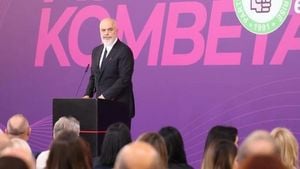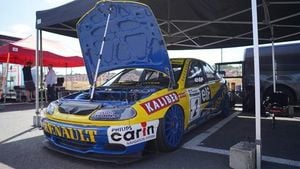At the much-anticipated "We, Robot" event held at the Warner Bros. Studios, Tesla CEO Elon Musk unveiled his futuristic vision for transportation: the Cybercab robotaxi. On October 10, 2024, Musk presented this steering wheel-less vehicle, alongside the Robovan, during a show laden with optimism and glitzy visuals.
The Cybercab, touted as the forefront of autonomous transport, marks Tesla's continued push toward eliminating drivers from the equation. It is expected to start production by 2026 at a price tag below $30,000. Described as resembling something out of Blade Runner—but with a cheerier twist—this robotaxi features butterfly doors and operates entirely without pedals.
During his approximately 20-minute presentation, Musk touted the potential of the Cybercab and its sibling vehicle, the Robovan, which can carry up to 20 passengers. He stated, "It’ll be like sitting in a comfortable little lounge.” He also emphasized the vehicle's inductive charging capability, eliminating the need for traditional charging cords, claiming it would transform electric vehicle infrastructure.
The glitz of the event overshadowed some underlying skepticism. After the show, onlookers noted Tesla's historic tendency for ambitious timelines and promises. Following Musk’s presentation, Tesla's stock took a hit, dropping nearly 9%, indicating investor nervousness about the company meeting these optimistic projections.
Musk's claims about the Cybercab raise questions about the timeline for fully autonomous vehicles. While he expressed confidence about unsupervised driving capabilities arriving by 2025, especially in California and Texas, industry experts remain doubtful. Autonomous technology still faces significant challenges, like adequately handling complex driving environments, dynamic weather conditions, and pedestrian interactions.
Despite Musk's assertion of the Cybercab's operating cost at around 20 cents per mile, critics point out the long and arduous road to regulatory approval may stall its rollout. Experts like Krzysztof Czarnecki, a professor specializing in electrical and computer engineering, believe there remains “a big gap” between presentation and reality, particularly concerning safety protocols necessary for autonomous operations.
Interestingly, Musk didn't merely promote the Cybercab; he also introduced the Robovan, presenting it as part of the future of mass transit. Designed to be more than just another ride-hailing service, Musk envisions the Robovan providing on-demand transportation solutions and facilitating owners to rent them out when not actively used.
While the overall reception from the audience was enthusiastic, the lack of clarity concerning regulations, production timelines, and Tesla's competitive position against companies like Alphabet's Waymo has left many investors questioning the viability of Musk's autonomous dream.
During the event, attendees had the chance to experience the Cybercab firsthand, as 20 units whirred around the studio lot, and humanoid robots like Optimus entertained the guests. Musk chips away at skepticism about Tesla’s technological prowess, but the enthusiasm was tempered by cautious optimism from those watching closely.
While Musk asserted his plans boldly, experts caution against taking things at face value. Analysts stress the importance of remaining realistic about the capabilities and readiness of Tesla's technology, especially when road-testing robotaxis already operating miles more than Tesla's fleets.
The stakes are high, and whether Tesla's ambitious plans will become reality remains uncertain. With competing technologies making headway, the race for autonomy is heating up. Musk may have set the stage for excitement and anticipation, but as every tech enthusiast knows; the proof will always be on the road.



